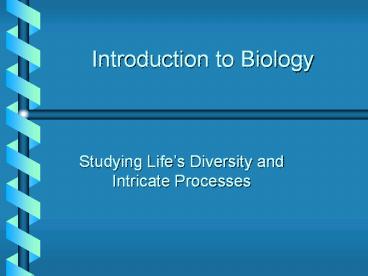Introduction to Biology - PowerPoint PPT Presentation
1 / 16
Title:
Introduction to Biology
Description:
Title: PowerPoint Presentation Author: SANTA MONICA CCD Last modified by: Jeff Davidson Created Date: 7/27/2000 7:48:06 PM Document presentation format – PowerPoint PPT presentation
Number of Views:96
Avg rating:3.0/5.0
Title: Introduction to Biology
1
Introduction to Biology
- Studying Lifes Diversity and Intricate Processes
2
What is this? Is it Alive?
3
Biological Inquiry
- Bio of living things
- What are the Characteristics of Living Things?
4
What are common characteristics of living things?
- Properties of Life
- organization involving cells
- energy use and metabolism
- response to environmental changes
- regulation and homeostasis
- growth and development
- reproduction
- biological evolution
5
Organizational Hierarchy of Life
biosphere
inhabitable regions of earth
ecosystem
coral reef (living nonliving)
community
coral reef populations
population
school of fish
organism
fish
organ system
nervous system
organ
brain
tissue
nervous tissue
cell
neuron
organelle
nucleus
macromolecule
DNA
molecule
nucleotide
atom
nitrogen
sub-atomic particles
protons, neutrons, electrons
6
Concept Cells are an Organisms Basic Units of
Structure and Function.
- Two types of cells
- Prokaryotic
- Archaea and Bacteria
- few internal membranes
- no membrane-bound nucleus
- Eukaryotic
- Protists, Fungi, Animals, Plants
- extensive internal membranes
- membrane-bound nucleus
organization
7
Concept Structure and Function are Correlated
at all Levels of Biological Organization.
- How is red blood cell structure suited to its
function of carrying oxygen?
organization
8
Energy Use and Metabolism
- Energy ability to do work
- Energy conversion change of one form of energy
to another - Metabolism sum of chemical reactions in an
organism - Heterotrophic other feeder
- taking in organic molecules produced by other
organisms - Autotrophic self-feeder
- photosynthesis using the energy of the sun to
produce organic molecules
9
Concept The Continuity of Life is Based on
Heritable Information in DNA.
- The molecule of heredity DNA
deoxyribonucleic acid
reproductionregulation
10
Concept The Continuity of Life is Based on
Heritable Information in DNA.
- Growth increase in size
- Development change in characteristics
growth and development
11
- Living things maintain homeostasis a
relatively stable internal condition
regulation and homeostasisresponse to
environmental changes
12
Concept Evolution Accounts for the Unity and
Diversity of Life
- Natural Selection leads to a change in the
genetic characteristics of a population ?
evolution - Adaptation characteristic that promotes
survival and reproduction
13
How Do Biologists Study Living Things?
- Hypothesis-based Science
- State the Problem
- Ask Questions or make Observations
- Formulate an Hypothesis tentative answer to
well-framed question - Make Predictions based on hypothesis
- Test Predictions by Conducting Experiments
- Analyze experimental data
- Determine whether data supports hypothesis
14
How Do Biologists Study Living Things?
- A good hypothesis is
- Testable
- experiments can be designed to test predictions
from the hypothesis - experimental results must be repeatable
- Falsifiable
- allows scientists to eliminate alternative
hypotheses
15
How Do Biologists Study Living Things?
- Testing hypotheses
- Controlled Experiment
- test designed to determine the effect of one
factor while keeping all other factors constant - experimental sample treated to test for effect
of the factor being studied - control sample treated like experimental in all
ways EXCEPT for the factor being studied
16
How Do Biologists Study Living Things?
- Supported Hypotheses
- Theory broad explanation of a natural
phenomenon that has been supported by a large
body of evidence - Principle or Law theory that has been supported
over a long period of time - Cell Principle
- All living things are composed of cells and cell
products all cells come from pre-existing cells. - Principle of Evolution
- Law of Gravity































